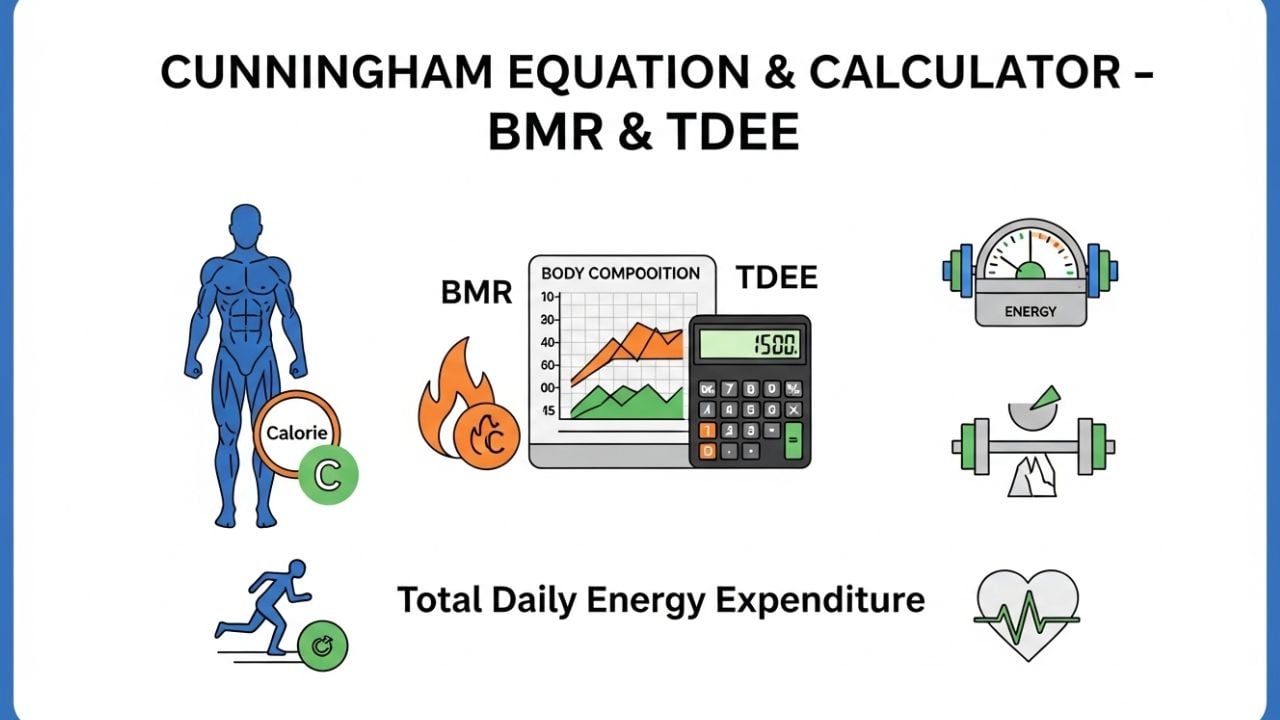Cunningham BMR Calculator
Elite metabolic rate calculator for very lean athletes and bodybuilders

Cunningham Equation
The Cunningham equation was developed specifically for very lean athletes and bodybuilders with body fat percentages below 10% (men) or 16% (women). Recent research from NCBI demonstrates that Cunningham provides superior accuracy (±3-5%) compared to traditional equations (±10-15%) in elite athletic populations, making it the gold standard for contest preparation and performance optimization.
Metabolic Precision
Unlike general population equations, Cunningham accounts for the increased metabolic activity in highly muscular, very lean individuals. ScienceDirect validation studies show that lean body mass in elite athletes burns approximately 22 calories per kilogram per day at rest, significantly higher than the 21.6 cal/kg used in the Katch-McArdle equation.
Cunningham Equation Formulas
Body Fat Standards & Cunningham Accuracy
| Category | Men (Body Fat %) | Women (Body Fat %) | Cunningham Accuracy | Recommended Use |
|---|---|---|---|---|
| Elite Athletes | 4-6% | 8-12% | Excellent (±2-3%) | Contest prep, elite bodybuilders |
| Competitive Athletes | 6-10% | 12-16% | Excellent (±3-5%) | Competitive bodybuilders, physique athletes |
| Above Optimal | 10-15% | 16-20% | Good (±5-8%) | Consider Katch-McArdle instead |
| General Population | 15%+ | 20%+ | Poor (±10-15%) | Use Harris-Benedict or Mifflin-St Jeor |
Note: Cunningham equation accuracy decreases significantly above 10% body fat (men) or 16% (women). For optimal results, body composition should be measured using professional methods like DEXA, hydrostatic weighing, or BodPod.
Professional Applications & Use Cases
Contest Preparation & Bodybuilding
Professional bodybuilders and physique competitors rely on Cunningham calculations during cutting phases to achieve stage-ready conditioning. Research demonstrates that precise caloric calculations prevent metabolic damage while ensuring optimal fat loss and muscle preservation. The equation’s accuracy at extreme leanness (3-8% body fat) makes it essential for contest preparation where every calorie matters.
Elite Athletic Performance
Clinical studies on high-level athletes show that Cunningham provides superior energy balance calculations for sports requiring low body fat percentages. Gymnasts, wrestlers, distance runners, and aesthetic sport athletes benefit from the equation’s precision during weight management phases without compromising performance or health.
Limitations & Important Considerations
Important Limitations to Consider
- Strict Body Fat Requirements: Accuracy rapidly decreases above 10% body fat (men) or 16% (women); equation becomes unreliable for general population use.
- Professional Body Composition Measurement: Requires DEXA, hydrostatic weighing, or BodPod for optimal accuracy; estimation methods significantly compromise precision.
- Limited Population Validation: Primarily validated in Caucasian athletic populations; may have ethnic-specific biases requiring adjustment.
- Metabolic Adaptation Effects: Prolonged extreme dieting can reduce metabolic rate independent of lean body mass, affecting equation accuracy during contest prep.
- Age and Gender Considerations: Limited validation in older athletes (>50 years) and may require adjustments for hormonal differences.
Scientific Research & Validation Studies
Elite Athlete Validation Studies
“New Predictive Resting Metabolic Rate Equations for High-Level Athletes”
NCBI Research (2022) –
This comprehensive study of 102 high-level athletes demonstrates that Cunningham provides superior accuracy
compared to traditional equations, with mean prediction errors of 3-5% versus 10-15% for Harris-Benedict.
The research confirms Cunningham’s effectiveness specifically for athletes with body fat below 10%.
Body Composition Applications
ScienceDirect Metabolic Research
Comprehensive validation study
examining body composition-based metabolic equations confirms Cunningham’s 22 cal/kg/day coefficient for lean body mass.
The research demonstrates significant improvements over general population equations when applied to very lean individuals,
particularly during contest preparation phases.
Optimization Tips & Best Practices
🎯 Maximize Accuracy for Contest Prep
Body Composition Timing: Measure body composition weekly during contest prep using the same method and time of day. Fast for 12+ hours and avoid training 24 hours before measurement. Maintain consistent hydration status as dehydration can artificially lower body fat readings by 2-3%, affecting Cunningham calculations during peak week.
🏆 Elite Athletic Applications
Sport-Specific Considerations: Adjust activity multipliers based on training phases. Elite athletes may require 2.0-2.2 multipliers during peak training with multiple daily sessions. Align caloric calculations with training periodization – higher calories during strength phases, lower during cutting phases, with Cunningham providing the baseline.
⚕️ Medical Disclaimer
This Cunningham calculator provides estimates based on established scientific equations and should not replace professional medical advice. Individual metabolic rates can vary significantly due to genetics, medical conditions, medications, and other factors. The Cunningham equation is specifically designed for very lean individuals and requires accurate body composition data for optimal results. Consult with healthcare professionals, registered dietitians, or certified nutritionists before making significant dietary changes, especially if you have pre-existing health conditions, are pregnant, breastfeeding, or taking medications that may affect metabolism. The calculations provided are for educational purposes and general guidance only.
Related
- Basketball Calories Burned Calculator
- Badminton Calories Burned Calculator
- Boxing Calories Burned Calculator
- Plank Calories Burned Calculator
- Burpee Calories Burned Calculator
- Crunches Calories Burned Calculator
- Sit-Up Calories Burned
- Zumba Calories Burned Calculator
- Pull Up Calories Burned Calculator
- Push-Up Calories Burned Calculator
- Home Activities Calories Burned Calculator
- Exercise Calories Burned Calculator
- Running Calorie Calculator
- Walking Calorie Burned Calculator
References
- Cunningham JJ. A reanalysis of the factors influencing basal metabolic rate in normal adults. Am J Clin Nutr. 1980 Nov;33(11):2372-4. doi: 10.1093/ajcn/33.11.2372. PMID: 7435418.
- Tinsley GM, Graybeal AJ, Moore ML. Resting metabolic rate in muscular physique athletes: validity of existing methods and development of new prediction equations. Appl Physiol Nutr Metab. 2019 Apr;44(4):397-406. doi: 10.1139/apnm-2018-0412. Epub 2018 Sep 21. PMID: 30240568.
- Freire R, Pereira GR, Alcantara JMA, Santos R, Hausen M, Itaborahy A. New Predictive Resting Metabolic Rate Equations for High-Level Athletes: A Cross-Validation Study. Med Sci Sports Exerc. 2022 Aug 1;54(8):1335-1345. doi: 10.1249/MSS.0000000000002926. Epub 2022 Apr 1. PMID: 35389940.

Manish is a NASM-certified fitness and nutrition coach with over 10 years of experience in weight lifting and fat loss fitness coaching. He specializes in gym-based training and has a lot of knowledge about exercise, lifting technique, biomechanics, and more.
Through “Fit Life Regime,” he generously shares the insights he’s gained over a decade in the field. His goal is to equip others with the knowledge to start their own fitness journey.
